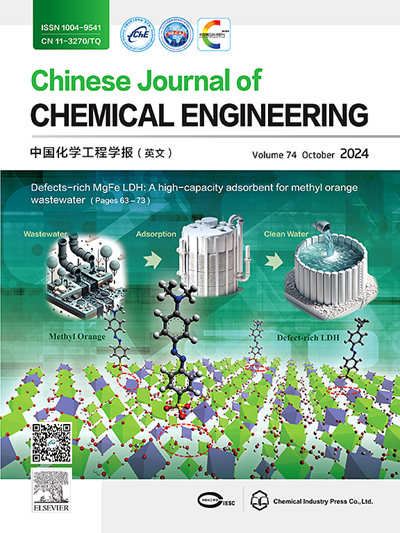A three-dimensional CFD numerical simulation study on pressurized oxy-fuel gasification of poultry manure in an industrial-scale gasifier
IF 3.7
3区 工程技术
Q2 ENGINEERING, CHEMICAL
引用次数: 0
Abstract
As a renewable energy source, the thermal conversion of poultry manure, is a promising waste treatment solution that can generate circular economic outputs such as energy and reduce greenhouse gas emissions. Currently, pressurized gasification of poultry manure is still a novel research field, especially when combined with a novel technological route of oxy-fuel gasification. Oxy-fuel gasification is a newly proposed and promising gasification technology for power generation that facilitates future carbon capture and storage. In this work, based on a commercially operated industrial-scale chicken manure gasification power plant in Singapore, we presented an interesting first exploration of the coupled pressurization technology for oxy-fuel gasification of poultry manure using CFD numerical simulation, analyzed the effects of pressure and oxygen enrichment concentration as well as the coupling mechanism between them, and discussed the conversion and emission of nitrogen- and sulfur-containing pollutants. The results indicate that under oxy-fuel gasification condition (Oxy-30, i.e., 30%O2/70%CO2), as the pressure increases from 0.1 to 0.5 MPa, the CO concentration in the syngas increases slightly, the H2 concentration increases to approximately 25%, and the CH4 concentration (less than 1%) decreases, resulting in an increase in the calorific value of syngas from 5.2 to 5.6 MJ·m−3. Compared to atmospheric pressure conditions, a relatively higher oxygen-enriched concentration interval (Oxy-40 to Oxy-50) under pressurized conditions is advantageous for autothermal gasification. Pressurization increases NO precursors production and also promotes homogeneous and heterogeneous reduction of NO, and provides favorable conditions for self-desulfurization. This work offers reference for the realization of a highly efficient and low-energy-consumption thermochemical treatment of livestock manure coupled with negative carbon emission technology.
工业级气化炉禽粪加压氧燃料气化的三维CFD数值模拟研究
作为一种可再生能源,禽畜粪便的热转化是一种很有前途的废物处理解决方案,可以产生能源等循环经济产出并减少温室气体排放。目前,禽粪加压气化仍是一个较新的研究领域,特别是与氧燃料气化这一新的技术路线相结合。氧燃料气化是一种新提出的有前途的发电气化技术,有助于未来的碳捕获和储存。本文以新加坡一家商业化运营的工业规模的鸡粪气化电厂为研究对象,首次利用CFD数值模拟对禽粪全氧气化耦合增压技术进行了有趣的探索,分析了压力和富氧浓度对气化过程的影响及其耦合机理,探讨了含氮、含硫污染物的转化和排放。结果表明:在全氧气化条件下(Oxy-30,即30%O2/70%CO2),当气化压力从0.1 MPa增加到0.5 MPa时,合成气中CO浓度略有增加,H2浓度增加到约25%,CH4浓度(小于1%)降低,导致合成气热值从5.2 MJ·m−3增加到5.6 MJ·m−3。与常压条件相比,加压条件下相对较高的富氧浓度区间(Oxy-40至Oxy-50)有利于自热气化。加压增加了NO前驱体的生成,促进了NO的均相和多相还原,为自脱硫提供了有利条件。本工作为实现畜禽粪便高效低耗热化学处理与负碳排放技术的结合提供了参考。
本文章由计算机程序翻译,如有差异,请以英文原文为准。
求助全文
约1分钟内获得全文
求助全文
来源期刊

Chinese Journal of Chemical Engineering
工程技术-工程:化工
CiteScore
6.60
自引率
5.30%
发文量
4309
审稿时长
31 days
期刊介绍:
The Chinese Journal of Chemical Engineering (Monthly, started in 1982) is the official journal of the Chemical Industry and Engineering Society of China and published by the Chemical Industry Press Co. Ltd. The aim of the journal is to develop the international exchange of scientific and technical information in the field of chemical engineering. It publishes original research papers that cover the major advancements and achievements in chemical engineering in China as well as some articles from overseas contributors.
The topics of journal include chemical engineering, chemical technology, biochemical engineering, energy and environmental engineering and other relevant fields. Papers are published on the basis of their relevance to theoretical research, practical application or potential uses in the industry as Research Papers, Communications, Reviews and Perspectives. Prominent domestic and overseas chemical experts and scholars have been invited to form an International Advisory Board and the Editorial Committee. It enjoys recognition among Chinese academia and industry as a reliable source of information of what is going on in chemical engineering research, both domestic and abroad.
 求助内容:
求助内容: 应助结果提醒方式:
应助结果提醒方式:


